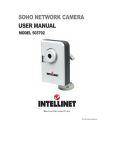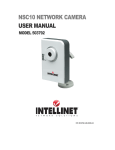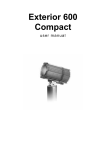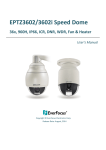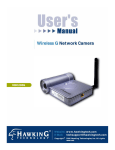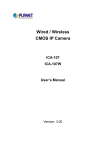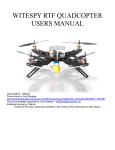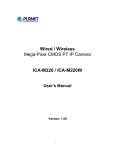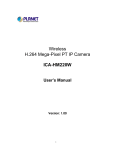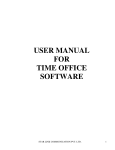Download LevelOne User`s Manual
Transcript
LevelOne FCS-1020 10/100Mbps Network Camera User’s Manual Ver. 3.11-0809 Contents 1. 2. 3. 4. 5. 6. Introduction.......................................................................................................... 1 Package Content ................................................................................................. 1 System Requirement ........................................................................................... 1 Hardware Installation........................................................................................... 2 4.1. LED and Focusing ............................................................................................2 4.2. Camera Ports....................................................................................................2 4.3. Installation Procedure .......................................................................................3 Software Installation ............................................................................................ 4 Using the Administrator Utility ........................................................................... 10 6.1. General Setting............................................................................................... 11 6.2. Detail Setting ..................................................................................................13 6.2.1. Network Setting.......................................................................................14 6.2.2. E-Mail Setting..........................................................................................15 6.2.3. PPPoE Settings ......................................................................................16 6.2.4. FTP Settings ...........................................................................................17 6.2.5. Date / Time Settings ...............................................................................18 6.2.6. Resolution ...............................................................................................19 6.2.7. Advanced Setting....................................................................................20 6.2.8. Users.......................................................................................................21 6.2.9. Tools .......................................................................................................22 6.2.10. About.......................................................................................................23 6.3. 7. Setting Wizard ................................................................................................24 Using the Camera Viewer.................................................................................. 26 7.1. Panel Introduction...........................................................................................26 7.2. Camera Buttons..............................................................................................27 7.3. Camera Status ................................................................................................28 7.4. Control Buttons ...............................................................................................28 7.5. Video Recording .............................................................................................29 7.6. Change Resolution .........................................................................................30 7.7. View Four Cameras Simultaneously...............................................................31 7.8. Viewer Utility Setting .......................................................................................32 7.8.1. Setting.....................................................................................................33 7.8.2. Video.......................................................................................................34 7.8.3. Recording................................................................................................36 7.8.4. Status ......................................................................................................38 7.8.5. General ...................................................................................................40 7.8.6. 8. 9. 10. 11. 12. 13. 14. About.......................................................................................................41 7.9. Playback .........................................................................................................42 7.10. Rotate Video ...................................................................................................44 Web Connection and Setup............................................................................... 45 8.1. Camera Setting...............................................................................................47 8.2. LAN Setting.....................................................................................................49 8.3. E-Mail and FTP...............................................................................................52 8.4. Motion Detection.............................................................................................53 8.5. System............................................................................................................54 8.6. Status..............................................................................................................56 8.7. Users ..............................................................................................................56 8.8. Log..................................................................................................................58 Frequently Asked Questions ............................................................................. 59 Technical Specifications .................................................................................... 60 Appendix A Router/Gateway Setup for Internet Viewing ................................... 61 Appendix B Viewing via UPnP in Windows XP.................................................. 63 Appendix C Configure Windows 2003 Server ................................................... 66 Appendix D GNU GENERAL PUBLIC LICENSE............................................... 68 1. Introduction Thank you for choosing FCS-1020. This IP camera sends live video through 10/100Mbps wired network to a web browser or camera viewer across Internet anywhere in the world! This compact, self-contained unit lets you keep an eye on your home, your kids, and your workplace—whatever’s important to you. How does the Camera do all of this? Unlike standard “web cams” that require an attached PC, FCS-1020 can connect directly to a network. The MJPEG video compression produces a high quality, high-frame rate, 640 x 480 video stream. The included Camera Viewer utility lets you record the video to your local hard drive, “live” or on a predetermined schedule. Use the instructions in this Guide to help you integrate the Camera into your network. These instructions should be all you need to get the most out of FCS-1020. 2. Package Content FCS-1020 Power Adapter Camera Stand and Bracket kit CD Manual/Utility Quick Installation Guide If any of the above items are missing, please contact your supplier. 3. System Requirement System requirement for PC or Notebook PC to access FCS-1020 are: OS System: Windows 2000, XP + SP2, Server 2003 IE Version: 6.0.29 + SP2 CPU: Intel Pentium III 750MHz above or Intel Celeron 1GHz above Memory Size: 128MB (256MB recommended) DirectX 9.0 or above VGA card with fully DirectX 9.0 supported. VGA Card Resolution: 800 x 600 or above or above 1 4. 4.1. Hardware Installation LED and Focusing Unpack FCS-1020 package and verify that all the items listed in the Chapter 2 are provided. The Camera head and its focus ring allow you to modify the aim and focus of the Camera. To adjust the Camera’s focus, rotate the dark focus ring. There are two LEDs indicating the camera status. Monitoring: When someone is viewing the camera, the LED will light. Ready: When the camera is power on and ready for access, the LED will light. LED LED Green: Monitoring Amber: Ready Focus ring 4.2. Camera Ports Unpack FCS-1020 package and verify that all the items listed in the Chapter 2 are provided. The Camera features two ports and a Reset button. Power: The Power port is where you will connect the power adapter. LAN: The LAN port is where you will connect the Ethernet network cable. Reset: The Reset button is what you will press if you need to reset the Camera to factory default settings. Insert a paper clip into the hole. Then press the button and hold it in for five 2 seconds. LAN Port Power Jack 4.3. Installation Procedure 1. Unpack FCS-1020 package and verify that all the items listed in the Chapter 2 are provided. 2. Connect FCS-1020 to your network by attached the network cable from the switch/router to the UTP port of FCS-1020. 3. Connect the power adapter to FCS-1020 and plug the power adapter to power outlet. FCS-1020 will be powered on. When FCS-1020 is ready, the Ready LED will light. 4. Make sure that you have installed correct VGA driver and DirectX 9.0 or above. Note: It is highly recommended to use the power adapter shipped with FCS-1020, do NOT use any other power adapter from any sources. 3 5. Software Installation Follow the simple steps below to run the Install Wizard to guide you quickly through the Installation process. The following installation is implemented in Windows XP. The installation procedures in Windows 2000/Server 2003 are similar. 1. Insert the CD shipped along with FCS-1020 into your CD-ROM drive. The “Autorun.exe” program should be executed automatically. If not, run “Autorun.exe” manually in the CD. 2. The Install Wizard will show four selections, select the program you want to install or click “Exit” to install the program later. The following installation steps are the demonstration of “Install Utility & Viewer”. 4 3. The system will start the installation procedures. Click “Next” to continue installation. 4. If you wish to install the software program in an alternate location, click “Change”; otherwise click “Next” to move on to the next step. 5 5. Click “Install” to start installing the program. 6. The system will install the program automatically. 6 7. Click “Finish” to complete the software installation. 8. ”Administrator Utility“ will be run automatically after installation. On FCS-1020 first page, the cameras found in the network are listed in the left window. Choose the one you want to configure and click “Setting Wizard” to proceed. “N” means the camera is new and not configured. 7 9. Please enter the default password “1234” and click “OK” to login to the IP setup page. 10. IP camera is working through the network (TCP/IP Protocol). The IP address and subnet mask setting must be correct, or you cannot access to the camera. The wizard program will detect the IP address status of your network automatically and suggest a free IP address for the Camera. You can accept the suggested value or enter the value manually. If you enter the value manually, please be aware that the “Subnet Mask” must be the same for both the camera and the PC. Click “Finish” to apply the configuration. 11. This wizard will pop up a window to ask you if you want to run the “Camera Viewer” and see the video of the Camera immediately. Select “OK” to run “Camera Viewer”. 8 12. The “Camera Viewer” will show the video automatically. Congratulations, you can use the camera through the network to view the video from now on. 9 6. Using the Administrator Utility The Administrator Utility allows users to search and setup the cameras located within the Intranet or on the Internet. From the utility, users can view all the information of the selected camera; furthermore, it provides a setting wizard, which can guide users to add the camera to the network easily and promptly. There are two ways to run the Administrator Utility as follows. 1. Click “Start”, select “\Program Files\Internet Camera\admin\admin.exe” to run the utility. 2. Double click the “IP Camera Admin” icon to run the utility. Once the utility is started, it will search all the cameras within the network. To do more settings, please refer to the description in the following sections. 10 6.1. General Setting LAN Auto Discover Click the button will search the camera within the network. Camera List The list shows the camera name and the setup status of the camera. It means the camera is in the default setting. It means the camera is configured before. Internet Add Click “Add” will appear a window for you to enter the IP Address of the camera on the Internet. Delete Click “Delete” to delete the camera from the list. Camera List The list shows the camera name and the connect status of the camera. 11 It means the camera is disconnected or not in the Internet. It means the camera is connected. Information of Camera Camera Information It displays all information of the selected camera. The information includes Firmware Version, Network Information, IP Address, UPnP Setting, DDNS Setting, Resolution and E-mail setting, etc. Camera Setting Detail Setting Click “Detail Setting” to do more setting of the camera such as IP address, Resolution, password and firmware upgrade, etc. Setting Wizard Click “Setting Wizard” to setup the necessary setting for the camera. 12 6.2. Detail Setting When you click the “Detail Setting”, a screen will pop up for you to enter the “Administrator Name” and “Password”. The default value is as follows. Name: “admin” Password: “1234” If the name and password you enter are correct, you can start to setup the camera. 13 6.2.1. Network Setting Network Setting IP camera Name The default camera name is “FCS-1020”. It is recommended to name a meaningful name for the camera. IP Address Enter an unused IP Address within the IP address range used on your LAN. If the IP Address of your LAN is from the 192.168.2.1 to 192.168.2.254, you can set an unused IP Address from the range for the camera, for example: 192.168.2.250. Subnet Mask The Subnet Mask field must match the subnet setting on your LAN. For example: 255.255.255.0. Gateway The Gateway is used to forward frames to destinations in a different subnet on the Internet. The Gateway setting must be the same with the gateway used by the PCs on your LAN. 14 DNS Server DNS Server (Domain Name Server) that translates names to IP addresses. Set the same DNS Server as the PCs on your LAN. Video Port The Video Port is used to transmit or receive the video streaming in the network. The default port setting is “4321”. If you want to view the video from the camera, the port setting should be correct. Web Port This camera support web connection, the default web port is 80. Since the web server may use port 80, you can use a different port for the camera. If you change the web port from 80 to 8080, you must type http://192.168.2.3:8080 to connect the camera through the web browser. 6.2.2. E-Mail Setting 15 E-Mail Setting Recipient E-Mail Address This camera supports “Snap Shot” and “Motion Detection” functions. You can snapshot a picture and send the picture by E-Mail. Enter the E-Mail Account for receiving the picture. SMTP Server Enter the SMTP Server for the E-Mail sending. Sender E-Mail Address Specified the e-mail address of the e-mail sender. Authentication Enable or Disable the SMTP Authentication function Username When Authentication is enabled, input the SMTP Username. Password When Authentication is enabled, input the password. Send a Test Email Press this button to send a test e-mail to your mailbox. You can use this function to test if your setting is correct. 6.2.3. PPPoE Settings 16 PPPoE Settings Enable/Disable If enable the PPPoE function, IP Camera will use PPPoE for network connection first. The default value is “Disable”. Username Enter the Username of PPPoE connection. Password Enter the Password of PPPoE connection 6.2.4. FTP Settings FTP Settings FTP Server This camera supports “Motion Detection” functions. When Motion Detection event occurred, you can record the pictures to FTP server. Enter the FTP address for receiving the pictures. 17 FTP Port Enter the port of the FTP server. User Name Specify the user account of ftp server. Password Specify the Password of your ftp account. Remote Folder Specify the folder of the ftp site that you want to store the video. Passive Mode If your Camera is under NAT, you usually need to enable this feature. 6.2.5. Date / Time Settings Date / Time Settings Set Date/Time manually Set the current Date and Time. NTP Server Synchronize the Date and Time with NTP server. 18 Time Zone Select the time zone that your camera put on. NTP Server Specify the IP Address of the NTP Server. 6.2.6. Resolution Resolution Resolution Select the desired video resolution format. Larger resolution requires more bandwidth. 640 x 480 is “VGA” format. 320 x 240 is “CIF” format. 176 x 144 is “QCIF” format. 19 6.2.7. Advanced Setting Advanced Setting UPnP When the UPnP function is enabled, the camera can be detected by UPnP compliant system such as Windows XP. The camera will be displayed in the Neighborhood of Windows XP, so you can directly click the camera to view the video through web browser. DDNS Many internet connections use a "Dynamic IP address", where the Internet IP address is allocated dynamically whenever the Internet connection is established. Internet users should know the IP Address of the camera when they want to connect to the camera every time. DDNS is designed to solve this problem, by allowing users to connect to your LAN using a domain name, rather than an IP address. Enable/Disable Enable or disable DDNS function of the camera. 20 Provider Several companies provide DDNS service. This camera supports the service from DynDNS who is one of the DDNS providers. Domain Name The domain name given by DynDNS is “registername.dyndns.com”. Enter the domain name that you register for the camera from DynDNS web site. Account Enter the login name for the DDNS service. Password Enter the password for the DDNS service. 6.2.8. Users Users Administrator Setting the password of Administrator account Current Password Enter the current password of the camera. 21 New Password Enter the new password you want to use for the camera. Confirm New Password Retype the new password to confirm the setting. User Setting the user account and password. Your camera can support 4 user account. 6.2.9. Tools Tools Firmware Version Display current firmware version. Firmware Update You can upgrade camera’s firmware via this function. Press this button and select the correct firmware to upgrade. 22 Reset to Default If you want to reset the camera, click this button. The default settings of the camera are as follows. Camera Name: “FCS-1020” IP Address: “192.168.2.3” Subnet Mask: 255.255.255.0 Administrator Name: “Admin” Password: “1234” Video Port: “4321” Web Port: “80” LED Light OFF 6.2.10. The function can turn off LED light manually. About About Administrator Utility Display current Administrator Utility Version. Version 23 6.3. Setting Wizard When you click the “Setting Wizard”, a screen will pop up for you to enter the “Administrator Name” and “Password”. The default value is as follows. Name: “admin” Password: “1234” If the name and password you enter are correct, you can start to setup the camera. Setting Wizard IP camera Name The default camera name is “FCS-1020”. It is recommended to enter a meaningful name for the camera. IP Address The wizard will auto setup an available IP Address to the camera. For example: if the IP address of the network is 192.168.2.x, the 24 wizard will search an unused IP Address from 192.168.2.1 to 192.168.2.250 and assign the camera an available IP Address. You are allowed to enter another IP Address to change the setting. Subnet Mask The wizard will auto search the Subnet Mask setting of the network and set the camera in the same Subnet Mask. You can enter another Subnet Mask to change the setting. Gateway The wizard will auto search the Gateway setting of the network and set the camera to use the same Gateway. You can enter another Gateway to change the setting. Video Port It defines the video stream port. The default value is “4321”. Cancel Click “Cancel” to stop wizard setting. Finish Click “Finish” to complete the camera setting. When you finish the camera setting, you can click “Ok” to run the “Camera Viewer” immediately or click “Cancel” to run the “Camera Viewer” later. 25 7. Using the Camera Viewer The Camera Viewer Utility allows users to view video up to four cameras. It also allows users to manual/schedule recording video and playback the video file. The status of camera viewing such as frame rate, video received, and etc. are also recorded in time. There are three ways to run the Camera Viewer Utility as follows. 1. Click “Start”, select “\Program Files\Internet Camera\util\util.exe” to run the utility. 2. Double click the “IP Camera Viewer” icon to run the utility. 3. Click “Setting Wizard” from Administrator Utility and follow the instructions in the utility. 7.1. Panel Introduction In the beginning when you start the Camera Viewer, you would see a Control Panel and a four division Viewer window. 26 7.2. Camera Buttons Camera Buttons Camera Click one of these four cameras will connect to the selected camera that you want to view and configure. If you want to remove the camera from the viewer, please right click the icon and select “Reset Camera x”. If you want to configure the camera, please right click the icon and select “Configure Camera x”. 27 7.3. Camera Status There is a status bar shown different color to indicate the status of each IP camera. Camera Status Yellow It means that there is no camera set to connect. Blue It means that the camera is connected and playing the live video. Pink It means that the camera is not connected now. Red It means that the camera is recording. 7.4. Control Buttons Pause Snapshot Close the Camera Viewer Minimize the Window Stop Record Play Forward Control Buttons Play The “Play” button is an intelligent play user-interface. In the normal display mode and FCS-1020 is disconnected, clicking on the “Play” can make the viewer connect to FCS-1020. In the 28 playback mode, clicking on the “Play” can play the video in the normal speed. The “Stop” button is an intelligent play user-interface. In the Stop normal display mode and FCS-1020 is connected, clicking on the “Stop” can make the viewer disconnect the camera. In the playback mode, clicking on the “Stop” can stop playing the video. Pause The “Pause” button provides you a way to pause the current video display. When the displaying video is paused, click on the “Play” again to resume the video display. Forward The “Forward” button to forward the speed of display when playback the recording file. Click the button at a time will increase the playing speed one time. Snapshot Click “Snapshot” will make the viewer to take a snapshot of the video and save the picture as a bitmap file in the hard disk. (You can set the directory for storing these bitmap files at the Section 7.8.4) Record By clicking “Record” you can record video immediately. (You can set the directory for storing video files at the section 7.8.4) 7.5. Video Recording This utility allows you record the video in AVI files. There are two ways of video recording – Manual Recording and Schedule Recording. Manual Recording You can manually record the video stream into an assigned video file. Click “Record” , then the viewer utility will start to record the video stream. You can assign the path in the setting dialog.(at section 7.8.4) 29 Clicking “Stop” will stop recording. Note: Before manual recording, you have to click the camera button to select FCS-1020 that you want to record first and make sure that the viewer is successfully connecting to FCS-1020. Schedule Recording You can assign a schedule and let this viewer automatically recording the video stream. Please refer to Section 7.8 to see how to setup schedule for the recording. The file name of the recorded video file is the start time of recording. For example, the file name “IPCamera_2004-10-8-23-56-40.avi” means it was recorded at 2004/10/8 23:56:40. 7.6. Change Resolution FCS-1020 supports two resolution, 640x480 (VGA) and 320x240 (CIF). You can change the resolution of each IP camera by clicking the resolution button. Note: Before changing the resolution of FCS-1020, you have to select FCS-1020 by clicking the camera button first. If you change the resolution of an IP camera, other clients who are viewing the same IP camera simultaneously will also see the video with the changed resolution, too. 30 Resolution VGA Change the resolution to 640x480 (VGA) mode. QVGA Change the resolution to 320x240 (QVGA) mode. 7.7. View Four Cameras Simultaneously Click the four division button can view the 4 cameras simultaneously in a four-division window. 31 7.8. Viewer Utility Setting Click the “Setting” button , then the setting window of FCS-1020 will pop up. Note: When you want to change the settings such as IP Address, Video Port, etc. in the “Setting” option, you must disconnect FCS-1020 first by clicking the “Stop” 32 .. 7.8.1. Setting Setting Name It is not required to fill the camera name for connecting camera. It is for users to identify the camera. IP Address IP address/Domain name of FCS-1020. Video Port The number of service port used by FCS-1020. Model Select a IP camera model which you are using. Username The user name for login into FCS-1020. By default, the user name is “admin”. Password The password for login into FCS-1020. By default, the password is “1234”. Discover Click “Discover”, then camera auto-discover windows will pop up. 33 The window will show all the discovered cameras on LAN environment for you to select. 7.8.2. Video You can setup schedule for the recording here. This utility will record the video stream in the assigned file folder according to the schedule automatically. The recorded video files are AVI format. Video Brightness You can adjust “Brightness” value in this function. The value is from 0 to 99(Default: 50). The image will be brighter when the value is bigger and bigger. Contrast You can adjust “Contrast” value in this function. The value is from 0 to 99(Default: 50). The contrast will be more obvious when the value is bigger and bigger. Saturation You can adjust “Saturation” value in this function. The value is from 0 to 99(Default: 50). The saturation will be more obvious when the value is bigger and bigger. 34 Hue You can adjust “Hue” value in this function. The value is from 0 to 99. The hue will be changed when the value is adjusted. Whiteness You can adjust “Whiteness” value in this function. The value is from 0 to 99. The whiteness level will be changed when the value is adjusted. Image Quality You can adjust image quality in this function. There are five levels can be selected. Max Frame Rate You can adjust frame rate in this function. There are 1 to 30FPS can be selected. Camera Frequency You can adjust camera frequency in this function. There are outdoor, 50Hz and 60Hz can be selected. Auto Exposure When you enable “Auto Exposure” function. The sensor will auto detect the illumination of environment and auto adjust the image brightness value. 35 7.8.3. Recording You can setup schedule for the recording here. This utility will record the video stream in the assigned file folder according to the schedule automatically. The recorded video files are AVI format. Note: 1. The utility will only start to record the video stream when this utility is running and is successfully connecting to FCS-1020 in the beginning of the schedule. 2. The schedule setting of one-time or weekly schedule should not overlap, or the recording will fail. 36 One-Time Schedule Weekly Schedule Schedule Cycle Recording Check this check box to enable cycle recording. When the Cycle Recording is checked and the storage usage has already reached the maximum reserved storage space, the utility will automatically delete the oldest recorded video file and use the space to store the newly recorded video stream. One-Time Schedule You can assign a range of time and the utility will automatically record the video stream only during the period of time. The default time is 2 minutes later from the current time. Weekly Schedule You can assign the days in a week and the period of time in a day when you want to record the video stream. The utility will automatically record the video stream during the periods of time 37 every week again and again. Schedule New Click “New” to add a new recording schedule. Edit Select an existing schedule in the schedule list and click “Edit” to edit the schedule. Delete Select an existing schedule in the schedule list and click “Delete” to delete the schedule. 7.8.4. Status You can see the current status information of the connection session between the utility and FCS-1020. Status Connected It displays “Yes” when the utility is connecting to FCS-1020 and displays “No” when the utility is not connecting to FCS-1020. Status 38 Stream Started At The beginning time of the current connection session between the utility and FCS-1020. Time Elapsed The elapsed time of the current connection session between the utility and FCS-1020. Video Received The total size (Unit is KByte) of video stream received during the current connection session between the utility and FCS-1020. Audio Received The total size (Unit is KByte) of audio stream received during the current connection session between the utility and a network camera (Reserved) Frame Rate The frame rate (frame per second) of the current video download speed from FCS-1020 to the utility. Data Rate The data rate (KByte per second) of the current video download speed from FCS-1020 to the utility. Number of Frames The total number of video frames received during the current connection session between the utility and FCS-1020. Number of Users The total number of users that viewing this camera currently. 39 7.8.5. General You can manage storage usage for this IP camera here. General Snap Shot Directory This lets you assign the directory where bitmap files will be stored when you click “Snapshot” to take pictures. The default folder is where the software program is installed, for example: “C:\Program Files\IP camera”. Record Directory This lets you assign the directory where the recorded video files will be stored. The default folder is where the software program is installed, for example: “C:\Program Files\IP camera”. Free Disk Space The current free disk space of the hard drive where is assigned to save recording files. Max Recording Space You can reserve a disk space to store the recorded video and snapshot files. If the space is run out, a message will pop up to remind you. 40 Used Disk Space The current used disk space for saving the recording file. Max Video File Size This let you assign a maximum size of each video file. The upper bound of this value is 2 GB per file. 7.8.6. About About Camera Viewer Utility Display current Camera Viewer Utility Version. Version 41 7.9. Playback Click the “Open File” and a “Load File” window will be popped up. Select the file that you want to play. The viewer will start to play the selected video file. 42 Playing Control Play When the video playback is in Stop state, just click “Play” and the viewer will play the video file from the beginning point. When the video playback is in Pause state, just click “Play” and the viewer will play the video file from the current pause point. When the viewer is playing with fast speed, just click “Play” to let the viewer play with the normal speed. Pause to When the recorded video is playing, you can click “Pause” freeze the playback. If you want the viewer to continue playing from the current pause point, just click “Play” Stop When the viewer is playing, you can click “Stop” . to stop the playback. If you want the viewer to play again, just click “Play” and the viewer will play the video file from the beginning point. Playing Control Forward If you want the viewer to play the video file in a faster speed when the viewer is playing the video file, just click “Forward” and the viewer will double the playing speed. If you want the viewer play with the normal speed when the viewer is playing with fast speed, just click “Play” 43 . 7.10. Rotate Video Rotate function lets you rotate the video frame 180 of degree angle each time you click the “Rotate” . With this function, you can view the live video with normal, and 180 degree angles counterclockwise. 44 8. Web Connection and Setup You can use the Web browser to connect the camera for viewing or setting. Open the web browser and enter the IP Address of the camera to establish a connection. The default IP Address of the camera is “192.168.2.3”. When the welcome screen appears, enter the “Admin Name” and “Password”. The default values are: Admin Name: “admin” Password: “1234” When the camera is connected, the browser will take you to the live video page. If you are viewing this camera at first time, the following dialog will appear to install the ActiveX plug in. Please check the publisher part, you should only accept it if it is published by DIGITAL DATA COMMUNICATIONS ASIA CO., LTD. 45 After installed the ActiveX plug-in, the video image will be shown up in the web screen directly. The menu options for the web control screen are as follows. Camera – View live video and adjust the video format from the menu. LAN – Setup the camera LAN port functions in the menu. WLAN – Setup the camera WLAN port functions in the menu. E-Mail & FTP – Setup the E-Mail client and FTP client in the menu. Motion Detection – Configure the Motion Detection Actions here. 46 System – Setup System utilities and settings in this menu. Status – Shows the camera information and current status in this page. Users – This camera support up to 4 user accounts. You can setup them in this menu. 8.1. Camera Setting Camera Setting Resolution Select the desired video resolution format. Larger resolution requires more bandwidth. 640 x 480 is “VGA” format. 320 x 240 is “CIF” format. The default resolution is CIF format. Image Quality Adjust this property to control the video quality Max Frame Rate Set the video max frame rate. This camera can support at most 30 frames per second. Set the frame rate higher can get video more smooth. But will use more bandwidth. Frequency Adjust this property to fitting light frequency. Brightness You can adjust the brightness of the video. If the video is too dark, you can input the larger number in this text box. The video will be brighter. This value can be from 1 to 99. 47 Contrast You can adjust the contrast by change the value. This value can be from 1 to 99. Saturation You can adjust the saturation by change the value. This value can be from 1 to 99. Hue You can adjust the hue by change the value. This value can be from 1 to 99. Whiteness You can adjust the white balance by change this value. This value can be from 10 to 30. Enable Auto Exposure You can enable Auto Exposure by check this box. Enable OSD You can enable or disable “Time Stamp” function in this item. When you disable “OSD” function, the “Time Stamp” will be hidden. Apply When you finish “AV Server” setting, click this button to validate the setting values. 48 8.2. LAN Setting LAN Network Type This camera can obtain IP via DHCP protocol or specified static IP Address to it.. IP Address Enter an unused IP Address within the IP address range used on your LAN. If the IP Address of your LAN is from the 192.168.2.0 to 192.168.2.250, you can set an unused IP Address from the range for the camera, for example: 192.168.2.250. Subnet Mask The Subnet Mask field must match the subnet setting on your LAN. For example: 255.255.255.0. Gateway The Gateway is used to forward frames to destinations in a different subnet on the Internet. The Gateway setting must be the same with the gateway used by the PCs on your LAN. DNS Server DNS Server (Domain Name Server) that translates names to IP addresses. Set the same DNS Server as the PCs on your LAN. Video Port The AV Control Port is used to transmit or receive the AV 49 streaming in the network. The default port setting is “4321”. If you want to view the video from the camera, the port setting should be correct. Web Port This camera support web connection, the default web port is 80. Since the web server may use port 80, you can use a different port for the camera. If you change the web port from 80 to 8080, you must type http://192.168.2.3:8080 to connect the camera through the web browser. Apply When you finish the “LAN”, click “Apply”. PPPoE Enable PPPoE Enable or disable PPPoE function of the camera. User Name Enter the User Name for the PPPoE Connection. Password Enter the Password for the PPPoE Connection. MTU A maximum transmission unit (MTU) is the largest size packet or frame, specified in octets (eight-bit bytes), that can be sent in a packet- or frame-based network such as the Internet. Apply When you finish the “PPPoE” setting, click “Apply”. Dynamic DNS Enable DDNS Enable or disable DDNS function of the camera. Provider Several companies provide DDNS service. This camera supports the service from DynDNS company. Domain Name The domain name given by DynDNS is “registername.dyndns.com”. Enter the domain name that you register for the camera from DynDNS web site. User Name Enter the login name for the DDNS service. Password Enter the password for the DDNS service. 50 Apply When you finish the “Dynamic DNS” setting, click “Apply”. UPnP Enable UPNP Enable or disable UPnP function of the camera. Apply When you finish the “UPnP” setting, click “Apply”. LoginFree Filename The default value is “loginfree”. That’s mean user can get a snapshot image from Internet Explorer. The format is like: IP Camera will send a snapshot image to Internet Explorer. If user changed file name (Ex: “1234”), the URL must be changed to “http://192.168.2.3/1234.jpg” Apply When you finish the “UPnP” setting, click “Apply”. 51 8.3. E-Mail and FTP The “E-Mail & FTP” lets you setup E-Mail client and FTP client that camera can sent live video to your e-mail account or FTP server when Motion has been detected. eMAIL & FTP Recipient E-Mail Address This camera supports “Motion Detection” function. Enter the E-Mail Account for receiving the pictures. SMTP Server Enter the SMTP Server for the E-Mail sending. Sender E-Mail Address Specified the e-mail address of the e-mail sender. SMTP Authentication Enable or Disable the SMTP Authentication function Username When Authentication is enabled, input the SMTP Username. Password When Authentication is enabled, input the password. Send a Test Email Press this button to send a test e-mail to your mailbox. You can use this function to test if your setting is correct. 52 FTP Server This camera supports “Motion Detection” functions. When Motion Detection event occurred, you can record the pictures to FTP server. Enter the FTP address for receiving the pictures. FTP Port Enter the port of the FTP server. User Name Specify the user account of ftp server. Password Specify the Password of your ftp account. Remote Folder Specify the folder of the ftp site that you want to store the video. Password When Authentication is enabled, input the password. Passive Mode If your Camera is under NAT, you usually need to enable this feature. 8.4. Motion Detection The “Motion Detection” allows users to setup the behavior of motion detection feature. Motion Detection Motion Detection Enable Enable or Disable the Motion Detection Function. 53 Next Event Detected Setup the interval between two events. For example, if you setup Interval the interval to 5 seconds, the next event will start after this event finished + 5 seconds. Threshold Setup the sensitivity of motion detection. Send Recording File to Select Yes to send the recorded video file to your e-mail account E-Mail that you had specified at “E-Mail & FTP” menu. E-Mail Subject Specify the subject of motion detection notify e-mail. Send Recording File to Select Yes to send the recorded video file to your FTP server that FTP you had specified at “E-Mail & FTP” menu. 8.5. System The “System” allows users to setup the camera’s parameters, like camera name, data/time setting. And also provide firmware upgrade and reset tools at this page. System Camera Name The default camera name is “FCS-1020”. It is recommended to 54 name a meaningful name for the camera. Login Name Setup your administrator account’s login name. Default name is “admin” Password Enter up to 4 digits password for the new user account. Confirm Password Enter the password again to confirm the setting. Set Date/Time manually Display the current Date and Time. NTP Server Synchronize the Date and Time with this NTP server. Time Zone Select the time zone that your camera put on. NTP Server Specify the IP Address of the NTP Server. Upgrade Firmware You can upgrade camera’s firmware via this function. Press the browse button, find the correct firmware and press upgrade. Reset to Factory Defaults If you want to reset all the camera settings to default, click this button. Reboot Device To reboot FCS-1020, click “Reboot”. LED Setting There are four LEDs to indicate the status of IP camera. If you wan to secure the camera from noticing, you can turn off the LED light by clicking “LED Light OFF”. To turn on the LED light, click “LED Light ON”. 55 8.6. Status The “Status” shows the current firmware version, uptime, system time and IP information of this camera. 8.7. Users The “Users” allows users to add four user accounts which are able to view video from Camera Viewer and Web Management. These users, unlike Administrator, are not allowed to configure the camera. 56 User 1 / 2 / 3 / 4 User # Enable or Disable the user number #. Login Enter the the login name to the camera. Password Enter up to 4 digits password for the new user account. Confirm Password Enter the password again to confirm the setting. Apply Click “Apply” to save the user account setting. 57 8.8. Log The “Log” allows users to monitor the device event and time. If you have trouble to use this device, the log file will help administrator to know the status of device. Log Log screen The screen will show event and event time of device. Refresh You can press “Refresh” button to refresh the log screen. 58 9. Frequently Asked Questions Q1: What is an IP camera? A: FCS-1020 is a standalone system connecting directly to an Ethernet or Fast Ethernet network. It is different from the conventional PC Camera; FCS-1020 is an all-in-one system with built-in CPU and web-based solutions providing a low cost solution that can transmit high quality video images for monitoring. FCS-1020 can be managed remotely, accessed and controlled from any PC/Notebook over the Intranet via a web browser or camera viewer. Q2: What algorithm is used to compress the digital image? A: FCS-1020 utilizes MJPEG video compression technology to provide high quality images. MJPEG is a standard for video compression and can be applied to various application software. Q3: Can I capture or record still images from FCS-1020? A: Yes, you are able to capture or record still images with the snapshot function from the Camera Viewer application supplied with FCS-1020 CD-ROM. Q4: What network cabling is required for FCS-1020? A: FCS-1020 uses Category 5 UTP Twisted-pair cable allowing 10 Base-T and 100 Base-T networking. Q5: Can FCS-1020 be setup as a PC-cam on the computer? A: No, FCS-1020 is used only on Ethernet and Fast Ethernet network. Q6: Can FCS-1020 be connected on the network if it consists of only private IP Addresses? A: Yes, FCS-1020 can be connected to a LAN with private IP Addresses. Q7: The focus on FCS-1020 is bad, how can I correct it? A: Adjust FCS-1020 focus manually. 59 10. Technical Specifications Video specification Max Resolution: 640 x 480 pixels Sensor: 1/4" color CMOS sensor Gain control: Automatic Exposure: Automatic White Balance: Automatic Focal Length: 4.8 mm Aperture: F=1.8 Image (Video Setting) Image compression: MJPEG Image Video Digital 24-bit Color Frame rate: 30fps@QVGA, 20fps@VGA Video resolution: 160x120, 320x240, 640x480 System Hardware LAN Connector: One RJ-45 port to connect to 10/100Mbps Ethernet LED Indicator: Monitoring LED (Green), Power LED (Amber) Power Supply: 5VDC, 1A HTTP/Utility Includes easy-to-use Viewer & Recorder utility Provides Admin utility & WEB browser Management View multiple cameras simultaneously - Up to 4 cameras at a time Manual/Schedule Record, Video Playback/Stop/Forward/Pause Supports four additional user accounts for viewing camera Auto sending Snap Shot by E-mail or FTP Support DDNS and UPnP functions Supports Windows 2000/XP/2003 Firmware Upgradeable EMI & Safety FCC, CE 60 11. Appendix A Router/Gateway Setup for Internet Viewing To view IP camera across the Internet, you have to make sure Router/Gateway has configured to pass incoming TCP/UDP connections from remote PC to FCS-1020. The Router/Gateway should set port forwarding or virtual server for the connections. Please see the illustration as below. Router/Gateway Port Forwarding/Virtual Server Setup Name Protocol Port LAN IP Setup 1 TCP 80 192.168.2.3 Setup 2 TCP 4321 192.168.2.3 Setup 3 UDP 13364 192.168.2.3 Port Definition Setup 1 It is the port of Web port. You have to configure the protocol to “TCP”. Setup 2 It is the port of Video port. You have to configure the protocol to “TCP”. Setup 3 It is the port for IP camera and Administrator Utility communication. The protocol setting should be “UDP”. Viewing IP camera via Web Browser Setup 1/Setup 2 If you want to view the video via Web Browser, you have to ensure the Router/Gateway has configured setup1 and setup 2. If 61 the web port is not default port “80”, but changed to 8080. The remote user has to enter http://203.30.212.82:8080. Viewing IP camera via Camera Viewer Utility Setup 2 If you want to use Camera Viewer Utility to view the camera, please make sure the Router/Gateway has configured setup2. Setup IP camera via Administrator Utility Setup 3 If you want to use Administrator Utility to configure FCS-1020 via Internet, the Router/Gateway should configure setup 3. 62 12. Appendix B Viewing via UPnP in Windows XP When the UPnP function is enabled, the camera can be detected by UPnP compliant system such as Windows XP. The camera will be displayed in the Neighborhood of Windows XP, so you can directly double click the camera or right click the camera and select “Invoke” to view the video through web browser. 63 Enable UPnP in Windows XP SP2 If you can’t find the camera in the Neighborhood of Windows XP SP2 or you have seen the following message when you double click the camera. You have to check if UPnP function is blocked by the firewall. Please follow the steps below to enable it. 1. Go to “Start\Settings\Network Connections”. 2. Right click the “Local Area Connection” and select “Properties”. 3. In the “Local Area Connection Properties”, select “Advanced” option menu and click “Settings”. 4. The “Windows Firewall” screen will be popped up, select “Exceptions” option menu. 64 5. Enable “UPnP Framework” from the “Programs and Services list” and click “Ok”. 65 13. Appendix C Configure Windows 2003 Server Graphics Hardware Acceleration and DirectX are disabled by default on a Server configuration to ensure maximum stability and uptime. But for any reason you need to enable them to use DirectX enabled applications this section will guide you through on how you can do it. Enabling Graphics Hardware Acceleration 1. Simply right click anywhere on your desktop and select Properties -> Settings tab -> Advanced -> and finally, the Troubleshoot tab. 2. Now move the Hardware acceleration slider across to Full 3. Click OK 4. You may experience a monitor black out for a few seconds, this is normal. 66 Enabling DirectX 5. go to Start -> Run -> and type dxdiag followed by enter. You will get a dialog box asking if you want to allow dxdiag to access the internet to check for valid WHQL certificates click on Yes. 6. Let's click on the Display tab, now click on all three boxes to enable DirectDraw, Direct3D and AGP Texture Acceleration. 67 14. Appendix D GNU GENERAL PUBLIC LICENSE Parts of the firmware of the FCS-1020 are subject to the GNU general public license. Licensing Information This product includes third-party software licensed under the terms of the GNU General Public License.. You can modify or redistribute this free software under the terms of the GNU General Public License.. Please see the later pages for the exact terms and conditions of this license. Specifically, the following parts of this product are subject to the GNU GPL: linux-2.4.26 bridge-utils-0.96 busybox-1.00-pre7 ppp-2.4.1 rp-pppoe-3.5 Wireless_tools.26 gcc-3.3.5 binutils-2.14 uClibc-0.9.26 All listed software packages are copyright by their respective authors. Please see the source code for detailed information. Availability of source code DIGITAL DATA COMMUNICATIONS ASIA CO., LTD. has made available the full source code of the GPL licensed software, including any scripts to control the compilation and installation of the object code in the GPL source part of website. No Warranty The free software included in this product is distributed in the hope that it will be useful, but WITHOUT ANY LIABILITY OF OR ANY WARRANTY FROM THE LICENSOR. 68 GNU GENERAL PUBLIC LICENSE Version 2, June 1991 Copyright (C) 1989, 1991 Free Software Foundation, Inc. 59 Temple Place - Suite 330, Boston, MA 02111-1307, USA Everyone is permitted to copy and distribute verbatim copies of this license document, but changing it is not allowed. Preamble The licenses for most software are designed to take away your freedom to share and change it. By contrast, the GNU General Public License is intended to guarantee your freedom to share and change free software--to make sure the software is free for all its users. This General Public License applies to most of the Free Software Foundation's software and to any other program whose authors commit to using it. (Some other Free Software Foundation software is covered by the GNU Library General Public License instead.) You can apply it to your programs, too. When we speak of free software, we are referring to freedom, not price. Our General Public Licenses are designed to make sure that you have the freedom to distribute copies of free software (and charge for this service if you wish), that you receive source code or can get it if you want it, that you can change the software or use pieces of it in new free programs; and that you know you can do these things. To protect your rights, we need to make restrictions that forbid anyone to deny you these rights or to ask you to surrender the rights. These restrictions translate to certain responsibilities for you if you distribute copies of the software, or if you modify it. For example, if you distribute copies of such a program, whether gratis or for a fee, you must give the recipients all the rights that you have. You must make sure that they, too, receive or can get the source code. And you must show them these terms so they know their rights. We protect your rights with two steps: (1) copyright the software, and (2) offer you this license which gives you legal permission to copy, distribute and/or modify the software. Also, for each author's protection and ours, we want to make certain that everyone understands that there is no warranty for this free software. If the software is modified by someone else and passed on, we want its recipients to know that what they have is not the original, so that any problems introduced by others will not reflect on the original authors' reputations. Finally, any free program is threatened constantly by software patents. We wish to avoid the danger that redistributors of a free program will individually obtain patent licenses, in effect making the program proprietary. To prevent this, we have made it clear that any patent must be licensed for everyone's free use or not licensed at all. The precise terms and conditions for copying, distribution and modification follow. 69 TERMS AND CONDITIONS FOR COPYING, DISTRIBUTION AND MODIFICATION 0. This License applies to any program or other work which contains a notice placed by the copyright holder saying it may be distributed under the terms of this General Public License. The "Program", below, refers to any such program or work, and a "work based on the Program" means either the Program or any derivative work under copyright law: that is to say, a work containing the Program or a portion of it, either verbatim or with modifications and/or translated into another language. (Hereinafter, translation is included without limitation in the term "modification".) Each licensee is addressed as "you". Activities other than copying, distribution and modification are not covered by this License; they are outside its scope. The act of running the Program is not restricted, and the output from the Program is covered only if its contents constitute a work based on the Program (independent of having been made by running the Program). Whether that is true depends on what the Program does. 1. You may copy and distribute verbatim copies of the Program's source code as you receive it, in any medium, provided that you conspicuously and appropriately publish on each copy an appropriate copyright notice and disclaimer of warranty; keep intact all the notices that refer to this License and to the absence of any warranty; and give any other recipients of the Program a copy of this License along with the Program. You may charge a fee for the physical act of transferring a copy, and you may at your option offer warranty protection in exchange for a fee. 2. You may modify your copy or copies of the Program or any portion of it, thus forming a work based on the Program, and copy and distribute such modifications or work under the terms of Section 1 above, provided that you also meet all of these conditions: a) You must cause the modified files to carry prominent notices stating that you changed the files and the date of any change. b) You must cause any work that you distribute or publish, that in whole or in part contains or is derived from the Program or any part thereof, to be licensed as a whole at no charge to all third parties under the terms of this License. c) If the modified program normally reads commands interactively when run, you must cause it, when started running for such interactive use in the most ordinary way, to print or display an announcement including an appropriate copyright notice and a notice that there is no warranty (or else, saying that you provide a warranty) and that users may redistribute the program under these conditions, and telling the user how to view a copy of this License. (Exception: if the Program itself is interactive but does not normally print such an announcement, your work based on the Program is not required to print an announcement.) These requirements apply to the modified 70 work as a whole. If identifiable sections of that work are not derived from the Program, and can be reasonably considered independent and separate works in themselves, then this License, and its terms, do not apply to those sections when you distribute them as separate works. But when you distribute the same sections as part of a whole which is a work based on the Program, the distribution of the whole must be on the terms of this License, whose permissions for other licensees extend to the entire whole, and thus to each and every part regardless of who wrote it. Thus, it is not the intent of this section to claim rights or contest your rights to work written entirely by you; rather, the intent is to exercise the right to control the distribution of derivative or collective works based on the Program. In addition, mere aggregation of another work not based on the Program with the Program (or with a work based on the Program) on a volume of a storage or distribution medium does not bring the other work under the scope of this License. 3. You may copy and distribute the Program (or a work based on it, under Section 2) in object code or executable form under the terms of Sections 1 and 2 above provided that you also do one of the following: a) Accompany it with the complete corresponding machine-readable source code, which must be distributed under the terms of Sections 1 and 2 above on a medium customarily used for software interchange; or, b) Accompany it with a written offer, valid for at least three years, to give any third party, for a charge no more than your cost of physically performing source distribution, a complete machine-readable copy of the corresponding source code, to be distributed under the terms of Sections 1 and 2 above on a medium customarily used for software interchange; or, c) Accompany it with the information you received as to the offer to distribute corresponding source code. (This alternative is allowed only for noncommercial distribution and only if you received the program in object code or executable form with such an offer, in accord with Subsection b above.) The source code for a work means the preferred form of the work for making modifications to it. For an executable work, complete source code means all the source code for all modules it contains, plus any associated interface definition files, plus the scripts used to control compilation and installation of the executable. However, as a special exception, the source code distributed need not include anything that is normally distributed (in either source or binary form) with the major components (compiler, kernel, and so on) of the operating system on which the executable runs, unless that component itself accompanies the executable. If distribution of executable or object code is made by offering access to copy from a designated place, then offering equivalent access to copy the source code from the same place counts as distribution of the source code, even though third parties are not compelled to copy the source along with the object code. 4. You may not copy, modify, sublicense, or distribute the Program except as expressly provided 71 under this License. Any attempt otherwise to copy, modify, sublicense or distribute the Program is void, and will automatically terminate your rights under this License. However, parties who have received copies, or rights, from you under this License will not have their licenses terminated so long as such parties remain in full compliance. 5. You are not required to accept this License, since you have not signed it. However, nothing else grants you permission to modify or distribute the Program or its derivative works. These actions are prohibited by law if you do not accept this License. Therefore, by modifying or distributing the Program (or any work based on the Program), you indicate your acceptance of this License to do so, and all its terms and conditions for copying, distributing or modifying the Program or works based on it. 6. Each time you redistribute the Program (or any work based on the Program), the recipient automatically receives a license from the original licensor to copy, distribute or modify the Program subject to these terms and conditions. You may not impose any further restrictions on the recipients' exercise of the rights granted herein. You are not responsible for enforcing compliance by third parties to this License. 7. If, as a consequence of a court judgment or allegation of patent infringement or for any other reason (not limited to patent issues), conditions are imposed on you (whether by court order, agreement or otherwise) that contradict the conditions of this License, they do not excuse you from the conditions of this License. If you cannot distribute so as to satisfy simultaneously your obligations under this License and any other pertinent obligations, then as a consequence you may not distribute the Program at all. For example, if a patent license would not permit royalty-free redistribution of the Program by all those who receive copies directly or indirectly through you, then the only way you could satisfy both it and this License would be to refrain entirely from distribution of the Program. If any portion of this section is held invalid or unenforceable under any particular circumstance, the balance of the section is intended to apply and the section as a whole is intended to apply in other circumstances. It is not the purpose of this section to induce you to infringe any patents or other property right claims or to contest validity of any such claims; this section has the sole purpose of protecting the integrity of the free software distribution system, which is implemented by public license practices. Many people have made generous contributions to the wide range of software distributed through that system in reliance on consistent application of that system; it is up to the author/donor to decide if he or she is willing to distribute software through any other system and a licensee cannot impose that choice. This section is intended to make thoroughly clear what is believed to be a consequence of the rest of this License. 8. 72 If the distribution and/or use of the Program is restricted in certain countries either by patents or by copyrighted interfaces, the original copyright holder who places the Program under this License may add an explicit geographical distribution limitation excluding those countries, so that distribution is permitted only in or among countries not thus excluded. In such case, this License incorporates the limitation as if written in the body of this License. 9. The Free Software Foundation may publish revised and/or new versions of the General Public License from time to time. Such new versions will be similar in spirit to the present version, but may differ in detail to address new problems or concerns. Each version is given a distinguishing version number. If the Program specifies a version number of this License which applies to it and "any later version", you have the option of following the terms and conditions either of that version or of any later version published by the Free Software Foundation. If the Program does not specify a version number of this License, you may choose any version ever published by the Free Software Foundation. 10. If you wish to incorporate parts of the Program into other free programs whose distribution conditions are different, write to the author to ask for permission. For software which is copyrighted by the Free Software Foundation, write to the Free Software Foundation; we sometimes make exceptions for this. Our decision will be guided by the two goals of preserving the free status of all derivatives of our free software and of promoting the sharing and reuse of software generally. NO WARRANTY 11. BECAUSE THE PROGRAM IS LICENSED FREE OF CHARGE, THERE IS NO WARRANTY FOR THE PROGRAM, TO THE EXTENT PERMITTED BY APPLICABLE LAW. EXCEPT WHEN OTHERWISE STATED IN WRITING THE COPYRIGHT HOLDERS AND/OR OTHER PARTIES PROVIDE THE PROGRAM "AS IS" WITHOUT WARRANTY OF ANY KIND, EITHER EXPRESSED OR IMPLIED, INCLUDING, BUT NOT LIMITED TO, THE IMPLIED WARRANTIES OF MERCHANTABILITY AND FITNESS FOR A PARTICULAR PURPOSE. THE ENTIRE RISK AS TO THE QUALITY AND PERFORMANCE OF THE PROGRAM IS WITH YOU. SHOULD THE PROGRAM PROVE DEFECTIVE, YOU ASSUME THE COST OF ALL NECESSARY SERVICING, REPAIR OR CORRECTION. REPAIR OR CORRECTION. 12. IN NO EVENT UNLESS REQUIRED BY APPLICABLE LAW OR AGREED TO IN WRITING 73 WILL ANY COPYRIGHT HOLDER, OR ANY OTHER PARTY WHO MAY MODIFY AND/OR REDISTRIBUTE THE PROGRAM AS PERMITTED ABOVE, BE LIABLE TO YOU FOR DAMAGES, INCLUDING ANY GENERAL, SPECIAL, INCIDENTAL OR CONSEQUENTIAL DAMAGES ARISING OUT OF THE USE OR INABILITY TO USE THE PROGRAM (INCLUDING BUT NOT LIMITED TO LOSS OF DATA OR DATA BEING RENDERED INACCURATE OR LOSSES SUSTAINED BY YOU OR THIRD PARTIES OR A FAILURE OF THE PROGRAM TO OPERATE WITH ANY OTHER PROGRAMS), EVEN IF SUCH HOLDER OR OTHER PARTY HAS BEEN ADVISED OF THE POSSIBILITY OF SUCH DAMAGES. END OF TERMS AND CONDITIONS This product incorporates open source code into the software and therefore falls under the guidelines governed by the General Public License (GPL) agreement. Adhering to the GPL requirements, the open source code and open source license for the source code are available for free download at http://global.level1.com. If you would like a copy of the GPL or other open source code in this software on a physical CD medium, LevelOne (Digital Data Communications) offers to mail this CD to you upon request, for a price of US$9.99 plus the cost of shipping. 74













































































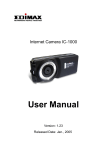
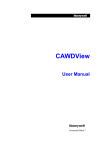

![Internet Camera - [ [ [ ANSEL ] ] ]](http://vs1.manualzilla.com/store/data/005837536_1-ce302c6b28431aa03d9b92e65549b72a-150x150.png)
